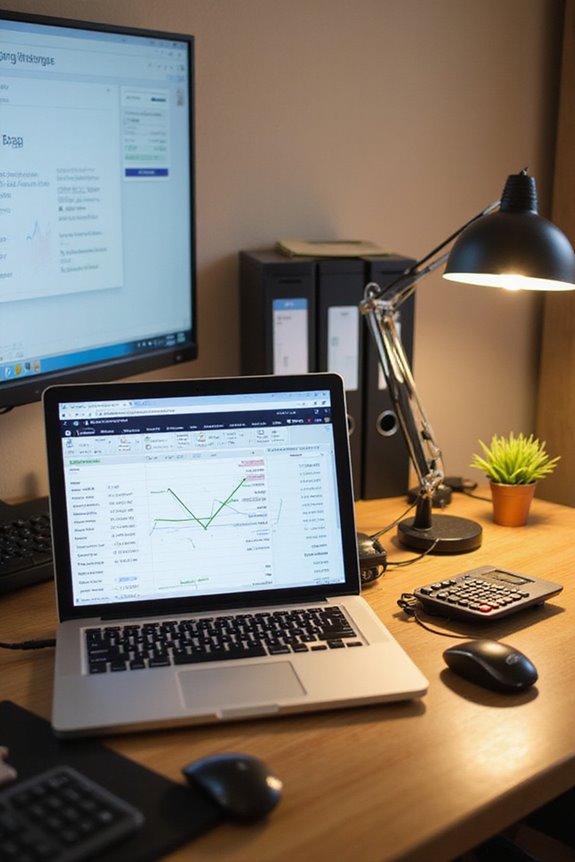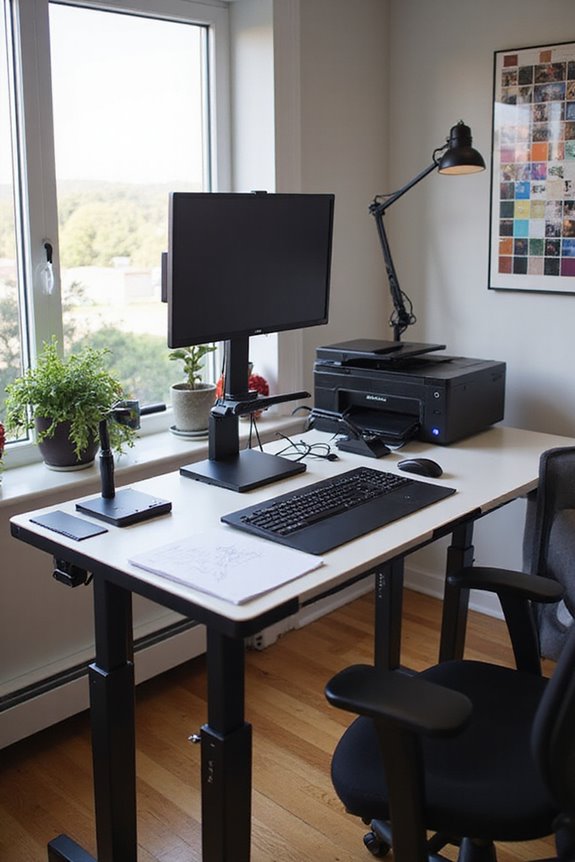Creating an effective home office for online teaching starts with optimizing your lighting. Place a primary light source slightly above eye level to minimize shadows. Choose ergonomic furniture, like an adjustable chair and desk, to enhance comfort and support. Eliminate distractions by keeping your workspace tidy and using soundproofing techniques. Invest in quality tech, including a reliable internet connection and essential equipment. By paying attention to these key aspects, you can foster a productive learning environment—and there’s more to explore.
Key Takeaways
- Optimize lighting by using soft, diffuse sources like ring lights to enhance video clarity and reduce shadows during online teaching.
- Choose ergonomic furniture, including an adjustable chair and desk, to maintain comfort during extended teaching sessions.
- Create a distraction-free environment by organizing your workspace, minimizing clutter, and positioning your desk away from high-traffic areas.
- Ensure robust technology setup with at least an Intel Core i5 processor, 8GB RAM, and a stable internet connection for smooth online classes.
- Implement backup systems, including a mobile hotspot and UPS, to safeguard against internet outages and power disruptions during lessons.
Optimize Your Lighting for Clarity
When setting up your home office for online teaching, one of the most critical elements to contemplate is your lighting. Effective lighting techniques can greatly enhance video clarity and viewer engagement. I recommend placing your primary light source in front of you, slightly above eye level, to illuminate your face and reduce shadows. Soft, diffuse lighting is ideal, as it minimizes harsh contrasts and creates a professional appearance. Consider investing in good lighting equipment like ring lights or softboxes, which evenly spread light and reduce glare. Avoid harsh overhead lights that create unflattering shadows. Remember, proper lighting not only improves your visibility but also makes your online teaching sessions more engaging for your students. Additionally, consider incorporating an LED desk lamp with adjustable brightness levels to customize your lighting to suit different tasks throughout your teaching day.
Choose the Right Furniture for Comfort
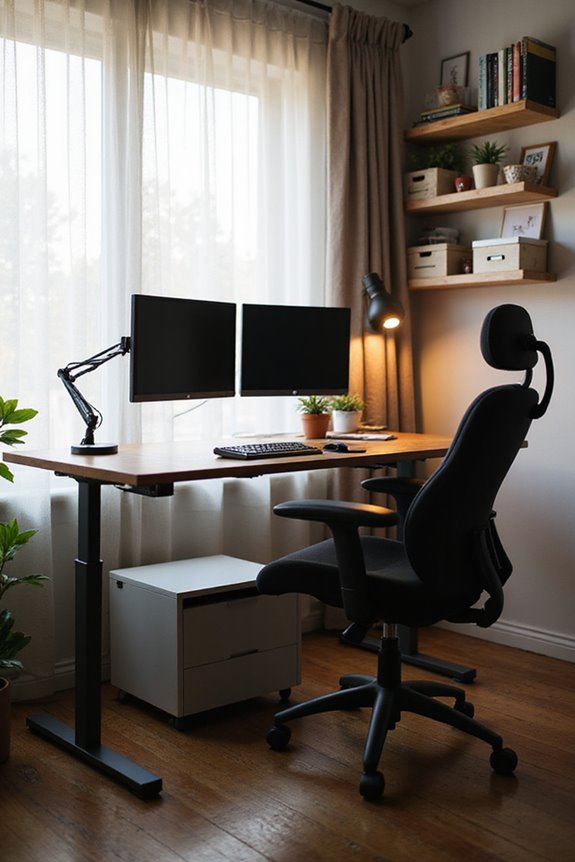
Choosing the right furniture for your home office is essential for creating a comfortable and productive environment. Start with an ergonomic chair that has adjustable height, lumbar support, and armrests—this is vital for a proper comfort assessment. Pair it with a sturdy desk that allows for an ergonomic desk height, ensuring your elbows rest at a 90-degree angle while typing. Consider incorporating a standing desk for flexibility during long teaching sessions.
When planning your furniture arrangement, think about privacy panels to minimize distractions, especially in shared spaces. Finally, adding footrests or back support pillows can enhance comfort further. Each piece plays a role in creating a workspace that supports both your teaching and your well-being. Additionally, selecting a chair with adjustable lumbar support can significantly reduce lower back discomfort during prolonged sitting.
Create a Distraction-Free Environment
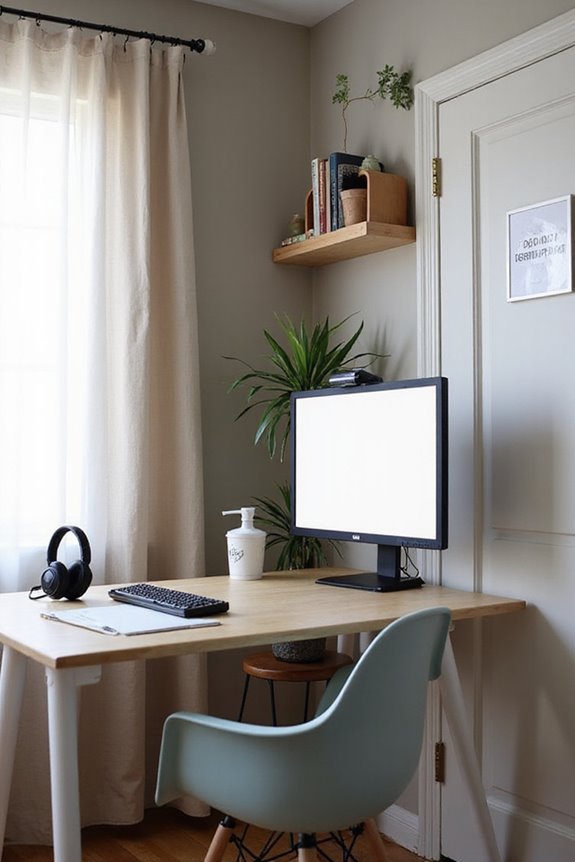
Creating a distraction-free environment is essential for effective online teaching, as it directly impacts your ability to focus and engage with students. To start, I recommend using soundproofing techniques like installing acoustic panels or heavy drapes to absorb noise. Positioning your desk away from high-traffic areas also helps minimize interruptions.
In terms of organization strategies, I keep only essential items on my desk and employ cable organizers to prevent clutter. Regular cleanup sessions keep my workspace tidy, while labeled containers store teaching materials for quick access. Additionally, incorporating acoustic foam panels can significantly enhance sound clarity in your home office. By implementing these techniques, I create a focused atmosphere that enhances my teaching experience and fosters better learning outcomes for my students.
Incorporate Decorative Elements for a Professional Look

In addition to establishing a distraction-free environment, incorporating decorative elements can greatly enhance the professionalism of your home office for online teaching. Start by selecting a calming color scheme, like blue or green, to promote focus. Adding decorative accents, such as textured rugs or woven baskets, introduces depth and warmth.
Inspiring artwork, particularly educational or motivational pieces, can elevate the space and create a stimulating learning environment. Make certain your furniture has a polished finish, whether wood or metal, to add a professional touch. Finally, consider using comforting fabrics, like muted-toned pillows or throws, to create a cozy ambiance without sacrificing professionalism. With these elements, your home office can be both functional and visually appealing.
Ensure Your Space Provides Privacy
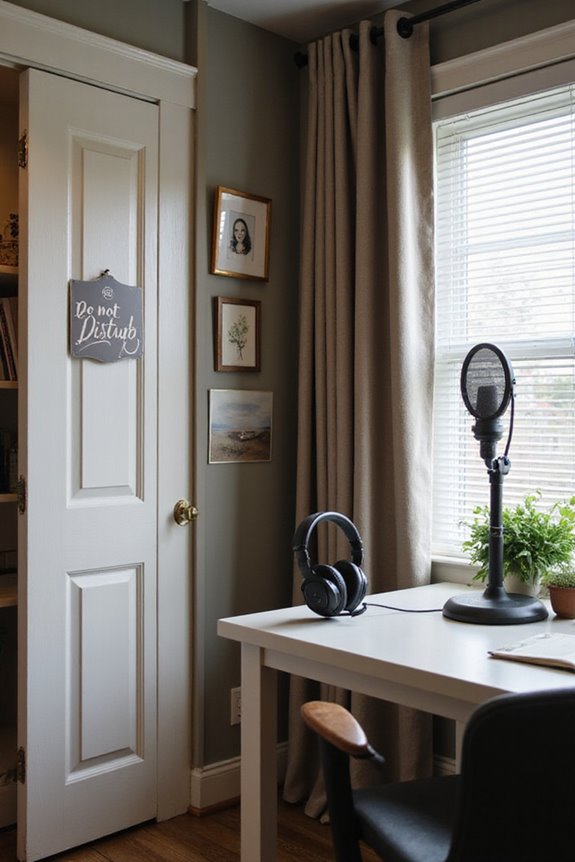
While establishing a home office for online teaching, maintaining privacy is essential for creating a conducive learning environment. First, I recommend positioning your workspace in a quiet area of your home, away from high-traffic zones. To enhance privacy measures, consider using curtains or blinds to block outside visibility and reduce noise. Room dividers can also help separate your office from living spaces.
Investing in soundproof solutions, such as acoustic panels, will minimize echo and background noise during lessons. Additionally, controlling entry to your office with doors or partitions limits distractions. Remember, a secure and private workspace not only protects your teaching environment but also helps your students focus better during online sessions.
Select Essential Equipment for Teaching

Selecting the right equipment for online teaching can greatly impact the quality of your lessons and student engagement. First, prioritize microphone selection; a clear USB microphone will enhance audio quality, making it easier for students to understand you. Next, consider webcam quality; a high-definition external webcam can notably improve visual clarity during your sessions.
Additionally, investing in a laptop stand can elevate your computer for better ergonomics. Proper lighting is vital too, as it enhances your professional appearance on camera. Finally, noise-canceling headphones can block distractions, allowing you to focus during lessons. By choosing these essential tools, you’ll create an effective and engaging online teaching environment that supports both you and your students. Furthermore, ensure that your microphone features a cardioid pickup pattern to minimize background noise and enhance clarity during your recordings.
Enhance Audio and Visual Quality
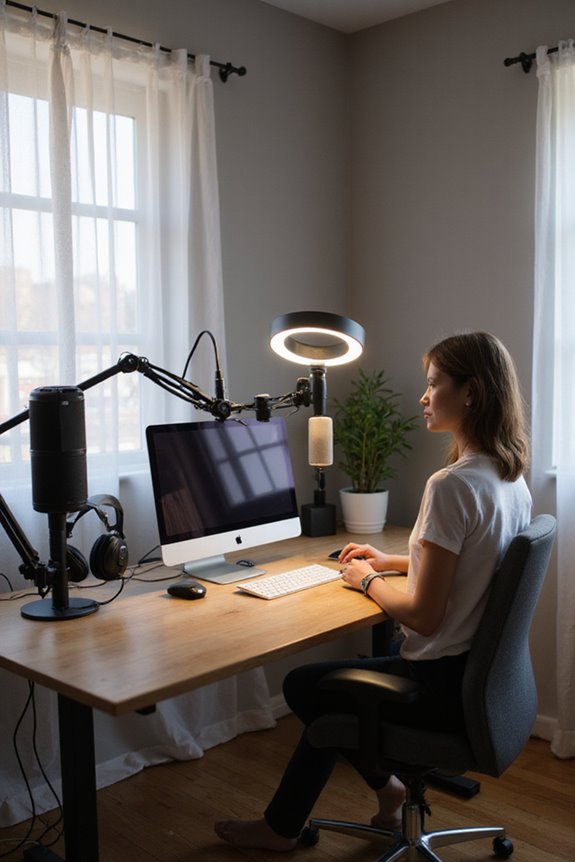
Enhancing audio and visual quality is vital for creating an effective online teaching environment. To improve audio, I recommend using a dedicated microphone, like the Rode NT-USB Mini, which guarantees clear sound. Position it close to you and consider using noise-canceling headphones and sound-absorbing materials to reduce background noise. For video clarity, upgrading to an external webcam, such as the Logitech C920s, greatly boosts image quality. Additionally, proper lighting is imperative; using ring lights can eliminate shadows. Always set your webcam to record in high resolution and place it at eye level to maintain an engaging presence. By implementing these audio enhancement techniques and video clarity tips, you’ll create a more professional online teaching experience. Furthermore, investing in 4K webcams can significantly enhance your video quality during online sessions.
Build a Professional Teaching Environment

Building a professional teaching environment is essential for facilitating effective online learning. I recommend creating a functional layout that prioritizes comfort and efficiency. Start by selecting an ergonomic desk and chair to support long teaching hours. Implement storage solutions to keep essential materials organized and within reach, which aids in resource organization.
Additionally, verify your workspace benefits from good lighting, ideally utilizing natural light. Minimize distractions by keeping your environment clutter-free and quiet. Incorporate a whiteboard or display for visual aids, and consider using multiple screens to streamline lesson management. A visually appealing background with plants or artwork can enhance the atmosphere, making it more inviting for your students. Overall, a well-structured environment greatly impacts the quality of your online teaching.
Maintain Technology and Connectivity for Smooth Operations
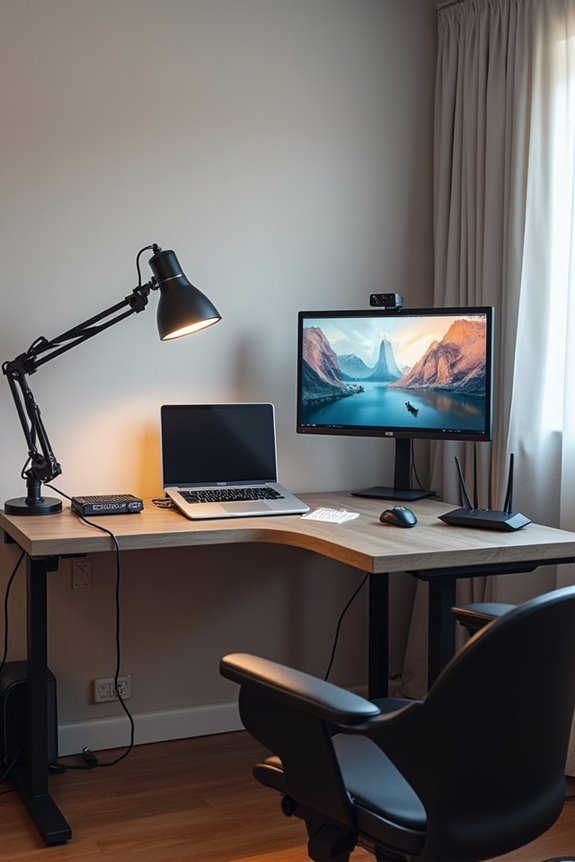
Maintaining technology and connectivity is essential for ensuring smooth operations in online teaching. To start, I recommend investing in a robust setup, including at least an Intel Core i5 processor, 8GB of RAM, and an SSD for peak performance. A stable internet connection, preferably wired, is vital; aim for a download speed of 10-20 Mbps. Don’t forget to have backup systems in place, such as a mobile hotspot or a secondary internet plan, to prevent disruptions. Additionally, prioritize network security by using firewalls and antivirus software to protect your data. Regular maintenance of your equipment and a UPS system for power outages can also help keep your online teaching running smoothly and securely.
Frequently Asked Questions
How Can I Stay Motivated While Teaching From Home?
Staying motivated while teaching from home can be tough. I set clear goals and use positive affirmations daily. It helps me stay focused, energized, and reminds me of my purpose in guiding my students.
What Are Effective Strategies for Engaging Online Students?
Did you know 76% of students prefer interactive activities? I’ve found incorporating polls and quizzes not only boosts engagement but also encourages valuable student feedback, making learning more enjoyable and effective for everyone involved.
How Often Should I Take Breaks During Teaching Sessions?
I believe taking breaks is essential for teaching effectiveness. I usually opt for a 10-minute break after every hour. It’s a perfect duration for a mental recharge, helping both me and my students stay engaged.
What Tools Can Help Me Manage Student Assignments?
When managing student assignments, I find assignment tracking tools like Google Classroom invaluable. They simplify grading, provide feedback, and make organizing everything easier, ensuring I stay on top of my students’ progress efficiently.
How Do I Handle Technical Issues During a Live Class?
Oh, the joys of tech hiccups during live classes! I’ve got troubleshooting tips and software solutions ready. Just remember, even the best plans can go awry, so stay calm and adapt on the fly!


